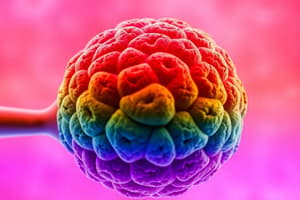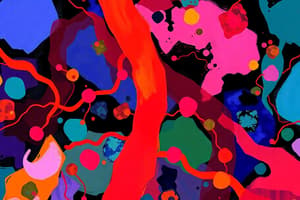Podcast
Questions and Answers
What is a benign tumor characterized by?
What is a benign tumor characterized by?
- Cells that can metastasize to other parts of the body
- Formation of secondary tumors in lymph nodes
- Invasive growth into surrounding tissues
- Neoplastic cells remain clustered together in a single mass (correct)
Which type of cancer arises from epithelial cells?
Which type of cancer arises from epithelial cells?
- Leukemia
- Sarcomas
- Lymphoma
- Carcinomas (correct)
Which of the following was reported as the most common cancer site in Europe in 2022?
Which of the following was reported as the most common cancer site in Europe in 2022?
- Lung cancer
- Breast cancer (correct)
- Prostate cancer
- Colorectal cancer
What is the primary feature associated with cancer development due to genetic changes?
What is the primary feature associated with cancer development due to genetic changes?
What does the term 'metastasis' refer to in cancer?
What does the term 'metastasis' refer to in cancer?
Which of the following is characterized as a malignant tumor?
Which of the following is characterized as a malignant tumor?
Which factor is traditionally recognized for its role in preventing cancer by regulating the cell cycle?
Which factor is traditionally recognized for its role in preventing cancer by regulating the cell cycle?
Which type of cancer arises from connective tissue or muscle cells?
Which type of cancer arises from connective tissue or muscle cells?
What is the significance of telomeres in cancer cells?
What is the significance of telomeres in cancer cells?
How do angiogenesis and tumor growth relate to each other?
How do angiogenesis and tumor growth relate to each other?
What is the trend regarding cancer survival rates as of 2019?
What is the trend regarding cancer survival rates as of 2019?
Which of the following describes a function of tumor suppressor proteins?
Which of the following describes a function of tumor suppressor proteins?
Which cells are associated with the cancer known as leukemia?
Which cells are associated with the cancer known as leukemia?
What happens when both alleles of a tumor suppressor gene are mutated?
What happens when both alleles of a tumor suppressor gene are mutated?
Which of the following is NOT considered a hallmark of cancer?
Which of the following is NOT considered a hallmark of cancer?
Which growth factor is associated with cancer cell proliferation and is also a type of oncogene?
Which growth factor is associated with cancer cell proliferation and is also a type of oncogene?
What distinguishes malignant tumors from benign tumors?
What distinguishes malignant tumors from benign tumors?
Which cancer type is specifically characterized by its origin from white blood cells?
Which cancer type is specifically characterized by its origin from white blood cells?
What is the primary characteristic of a benign tumor?
What is the primary characteristic of a benign tumor?
Which of the following factors contributes to cancer being considered an age-related disease?
Which of the following factors contributes to cancer being considered an age-related disease?
What is the term for cancer that arises from lymph nodes?
What is the term for cancer that arises from lymph nodes?
Which type of cancer typically has the highest mortality rate as of 2022?
Which type of cancer typically has the highest mortality rate as of 2022?
What is the process by which malignant tumors can form secondary tumors at distant sites?
What is the process by which malignant tumors can form secondary tumors at distant sites?
Which of the following statements accurately describes the characteristics of carcinomas?
Which of the following statements accurately describes the characteristics of carcinomas?
What is a significant consequence of mutations in oncogenes?
What is a significant consequence of mutations in oncogenes?
How can tumor suppressor proteins contribute to cancer development?
How can tumor suppressor proteins contribute to cancer development?
Which process is primarily associated with the need for tumors to sustain their growth?
Which process is primarily associated with the need for tumors to sustain their growth?
What is a common alteration seen in cancer cells regarding growth factors?
What is a common alteration seen in cancer cells regarding growth factors?
What event can lead to unlimited replicative potential in cancer cells?
What event can lead to unlimited replicative potential in cancer cells?
What would likely occur if both alleles of a tumor suppressor gene are mutated?
What would likely occur if both alleles of a tumor suppressor gene are mutated?
Which type of gene is involved in the regulation of transcription factors and contributes to anti-proliferative functions?
Which type of gene is involved in the regulation of transcription factors and contributes to anti-proliferative functions?
Which change is necessary for the development of cancer involving cellular signals?
Which change is necessary for the development of cancer involving cellular signals?
Flashcards
Benign Tumor
Benign Tumor
An abnormal mass of tissue that grows uncontrollably but remains confined to its original location and does not spread to other parts of the body.
Malignant Tumor
Malignant Tumor
A tumor that has the ability to invade surrounding tissues and spread to other parts of the body through the bloodstream or lymphatic system.
Leukemia
Leukemia
Cancer originating from white blood cells, affecting the blood-forming tissues in the bone marrow.
Lymphoma
Lymphoma
Signup and view all the flashcards
Carcinoma
Carcinoma
Signup and view all the flashcards
Sarcoma
Sarcoma
Signup and view all the flashcards
Invasiveness
Invasiveness
Signup and view all the flashcards
Metastasis
Metastasis
Signup and view all the flashcards
Mutations in cancer
Mutations in cancer
Signup and view all the flashcards
Oncogenes
Oncogenes
Signup and view all the flashcards
Tumor suppressor proteins
Tumor suppressor proteins
Signup and view all the flashcards
P53 gene
P53 gene
Signup and view all the flashcards
Unlimited replicative potential in cancer
Unlimited replicative potential in cancer
Signup and view all the flashcards
Tumor-associated neovasculature
Tumor-associated neovasculature
Signup and view all the flashcards
Loss of adhesion molecules
Loss of adhesion molecules
Signup and view all the flashcards
Hallmarks of Cancer
Hallmarks of Cancer
Signup and view all the flashcards
Carcinogenesis
Carcinogenesis
Signup and view all the flashcards
PET Scan
PET Scan
Signup and view all the flashcards
Radiolabeled fluorodeoxyglucose (FDG)
Radiolabeled fluorodeoxyglucose (FDG)
Signup and view all the flashcards
The importance of p53
The importance of p53
Signup and view all the flashcards
Unlimited replicative potential
Unlimited replicative potential
Signup and view all the flashcards
Study Notes
Introduction to Carcinogenesis
- Non-Hodgkins lymphoma is a type of cancer
- Radiolabeled fluorodeoxyglucose (FDG) is used in PET scans
- PET scans are used in medical imaging
Hallmarks of Cancer
- Cancer research has revealed that cancer involves dynamic changes in the genome
- The hallmarks of cancer are six biological capabilities acquired during the development of human tumors
- These hallmarks organize the complexities of neoplastic disease
- Examples of hallmarks: sustaining proliferative signaling, evading growth suppressors, activating invasion and metastasis
Carcinogenesis: Introduction
- Cancer has a significant impact
- Some definitions of cancer include: benign tumors (neoplastic cells remain clustered together in a single mass), malignant tumors (cancer cells have acquired the ability to invade surrounding tissue)
- Hallmarks of cancer are an important concept for understanding this disease
- Literature references include: "Hallmarks of Cancer: The Next Generation" (Cell 2011, pg 646-654) and chapter 20 of MBC 6th Edition (pgs 1091-1126)
Some, not so nice, numbers
- An estimated 2.7 million new cases of cancer and 1.3 million deaths from cancer occurred in Europe in 2022
- The most common cancer sites were female breast, colorectal, prostate, and lung cancers
- The most common causes of cancer death were lung, colorectal, breast, and pancreatic cancers
Cancer is an age-related disease
- The incidence of cancer increases with age across all sexes and cancer types
20-Year Lag Time Between Smoking and Lung Cancer
- Cigarette consumption (men) increased gradually over decades
- Lung cancer deaths (men) increased after a 20-year delay mirroring cigarette consumption patterns
Why are lung cancer rates still rising for women?
- The percentage of women smoking increased as rates rose for lung cancer
- The number of women smokers and lung cancer rates have both continued to rise
Breast Cancer Incidence Worldwide
- Age-standardized rates of breast cancer incidence differ significantly across countries showing significant variations
Breast Cancer Mortality Worldwide
- Age-standardized rates of breast cancer mortality differ significantly across countries showing significant variations
Breast cancer
- One in eight women will develop breast cancer during their lifetime
- The graphic illustrating one in eight needs improvement to be more accurate.
Cancer survival increases
- Overall cancer survival rates for both sexes and each individual gender have increased over time
For most cancers survival improved!
- 5-year survival rates have improved over time across many cancer types
Some definitions
- Leukemia: cancer arising from white blood cells
- Lymphoma: cancer arising from lymph nodes
- Carcinomas: cancer arising from epithelial cells (e.g., skin, breast, lung)
- Sarcomas: cancer arising from connective tissue or muscle cells, such as bone and soft tissue
How many mutations are necessary to transform normal cells into cancerous cells?
- Mutations are necessary for transforming normal cells into cancerous cells
Six changes are needed to cause cancer
- Six hallmarks have been found that are essential to the development of multiple cancers. These include resisting cell death, inducing angiogenesis, sustaining proliferative signaling, enabling replicative immortality, evading growth suppressors and activating invasion and metastasis
Most prominent feature is:
- Hallmarks are grouped into circuits including motility, proliferation, cytostasis/differentiation, and viability to show their relationships to each other and to other characteristics of cancer
Removal of the brake:
- The same characteristics are grouped into circuits according to how they work together. These include motility, proliferation, cytostasis/differentiation, and viability, to show their relationships to each other and to other aspects of cancer
The importance of P53:
- P53 is an important characteristic in cancer development
Unlimited replicative potential:
- Telomeres are extremely important in allowing cancer cells to continue to replicate.
Tumors need food!
- Tumors require blood vessels to provide nutrients and oxygen
- Vascular endothelial growth factor (VEGF) is important in tumor growth
Loss of adhesion molecules:
- Adhesion molecules are critical for preventing cancer spread
- The loss of adhesion creates a mechanism for cancer cells to metastasize
Acquired Capability / Example of Mechanism
- A chart showing what mechanisms cause acquired cancer capabilities
- The chart is composed of different acquired capabilities, each with their own description of the mechanisms responsible
Cellular causes for cancer development
- Overactivity of Growth Promoting events (e.g., GF signaling, factors)
- Underactivity or Growth Inhibitory events (e.g., DNA repair, apoptosis)
The cancer genes
- Oncogenes are overactive genes that cause normal cells to grow
- Tumor suppressors are genes that help prevent cancer growth
- Mutations in these genes can lead to cancer development
Emerging Hallmarks
- Deregulating cellular energetics and avoiding immune destruction have been shown to play a role in cancer
Understanding the Warburg effect
- A change in how cells use glucose to produce energy
- Cancer cells primarily use glycolysis for energy
Evading immune destruction
- A key characteristic of cancer cells is their ability to avoid detection and destruction by the immune system
- Tumor cells often lack or alter the expression of tumor-specific antigens recognized by T cells
Enabling characteristic, tumour promoting inflammation
- Inflammation is a key enabling characteristic of cancer
- Inflammation can provide bioactive molecules that promote cancer growth, angiogenesis, and survival
Enabling characteristic, genomic instability
- Genomic instability is a key enabling characteristic of cancer
- There is an increased rate of mutations in tumor cells due to breakdown in maintenance machinery and compromised surveillance systems
Therapeutic Targeting
- A diagram showing how targeted therapies aim at manipulating the hallmarks
Studying That Suits You
Use AI to generate personalized quizzes and flashcards to suit your learning preferences.




